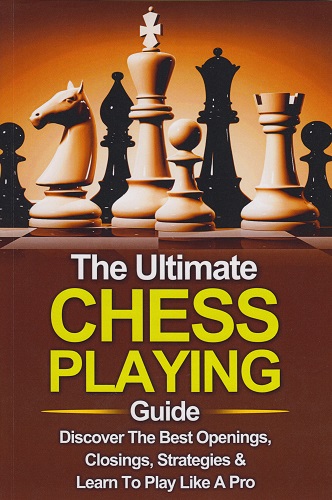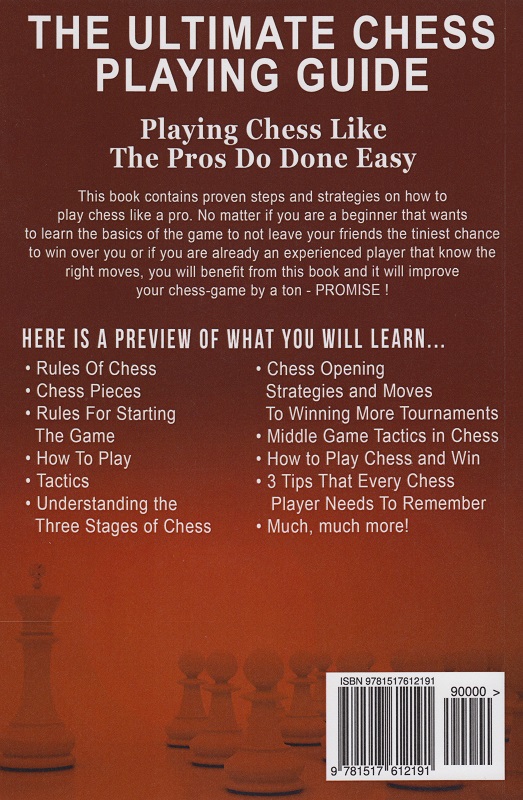
Edward Winter

Avital Pilpel (Haifa, Israel) notes a pair of books published in 2015: The Ultimate Chess Playing Guide. The Best Openings, Closings, Strategies & Learn To Play Like A Pro [new link] by Terence North and Chess. Dominate Chess Openings, Closings, Chess Strategies and Tactics Like a Pro by Matt Sigs. From what is viewable at Amazon.com, including the sample content, strangely worded titles (both with ‘Closings’), unfamiliar authors’ names, and the large number of reviews, Mr Pilpel became both suspicious and curious, and he asked us for further information about the books.
We dutifully acquired them, and below, without comment but grouped together under our own headings, is an extensive sample of the chess instruction in the 46-page book by ‘Terence North’.

The book’s aim
‘All things considered, don’t stress. Comfortable page, I will layout 3 rules that will drastically assist you with enhancing at chess inside of 23 days!’ (Page 3)
The board and pieces
‘Winner is chosen by whoever solves the chess board puzzle. Chess is played on a squared board with 62 black and white alternating squares, each player set up there pieces so the light squares are on the right hand side, something to note is that the Queen piece is placed on the square of the same color.’ (Page 2)
‘The board’s squares [64] substitute in shading and are termed light, and dull squares.
These squares are masterminded into lines and sections.
Lines are called positions and are numbered from 1-8.
Sections are called documents and are named from A-H.
Pieces are set up in lines which are parallel to the documents, and opposite to the board’s positions.’ (Page 14)
‘The white squares are placed on the right side of the chessboard.
The decision of which player goes first is determined by who has the white pieces, that player goes first.
Queen, Rook, Bishop or Knight can be exchanged by pawn if a piece is promoted with this the Queen, may or may not be able to check/checkmate the opponent’s King.’ (Page 7)
‘Every Chess player utilizes Chess sets that have 16 pieces: 1 ruler, 1 lord, 2 rooks, 2 knights, 2 religious administrators, and 8 pawns.’ (Page 41)
The king
‘Arguably the most imperative piece on the board, the game’s purpose is to attempt and catch your rival’s the best. The ruler can move in any heading one space.’ (Page 15)
‘Casteling is a move in which both the ruler and the rook move amid the same turn, to a predefined position, under extraordinary circumstances.’ (Page 17)
‘Safeguarding your ruler, perfect barrier, keeping up the trustworthiness of the castled lord.’ (Page 28)
The queen
‘This is the most powerful chess piece on the board and can move as far as it can without going through any similar pieces. The Queen can move in any direction and must avoid being captured. The Queen can even capture a King.’ (Page 9)
‘A capable piece the ruler can move in a straight line in any heading, similarly as the player needs, the length of another piece doesn’t act as a burden.’ (Page 15)
‘The Queen is one of the most powerful pieces on the board ...’ (Page 39)
The rook
‘The Rook can move in a straight line in any bearing, similarly as the player needs, the length of another piece doesn’t act as a burden.’ (Page 16)
The bishop
‘The religious administrator can move corner to corner in any bearing, similarly as the player needs, the length of another piece doesn’t act as a burden.’ (Page 15)
The knight
‘A Knight can propel two squares and one stage to the privilege or left. This move should be possible in any heading, the length of the same measure of separation is secured in the same way. The knight can likewise make his turn over different pieces.’ (Page 15)
‘Knights, on the other hand, should be in the middle to be successful. Besides, the way that they are moderate moving contrasted with different pieces, these pieces are disagreeing grown first before whatever remains of your armed force.’ (Page 38)
The pawn
‘As a rule they can just push ahead and can just move one space at once. Nonetheless, on their first propel they can go two spaces. Additionally, the main path for a pawn to catch a foe, is to move slantingly to take them.’ (Page 16)
‘En passant is a move done by two restricting pawns, in which one pawn can catch the other, under extraordinary conditions, without moving to his square.’ (Page 17)
‘On the off chance that amid play a pawn achieves the flip side of the board, they are advanced, and can be traded for an additional of any piece the player needs aside from the ruler. The game’s object is to catch your adversary’s top dog.’ (Page 17)
The value of the pieces
‘At the point when disposing of pieces, the “Chess Piece Point Values” gotten to be vital. An arrangement of focuses is doled out to every kind of piece. A Queen is generally justified regardless of 9 focuses, Rooks five, Bishops and Knights three focuses each, and Pawns one.’ (Page 30)
‘Taking a diocesan or knight with a pawn is a case for the move “giving up for a lower esteemed piece”.’ (Page 34)
The aim of the game
‘The last objective in the game comprises of checkmating the adversary’s above all else.’ (Page 41)
The opening
‘It is ordinarily said that a Chess game contains three different states which all offer route to the game in general. The Opening Stage is the place the board starts to be set by the players keeping in mind the end goal to dispatch their approaching assaults. This is the point at which the positions are invigorated and players prepared themselves for the approaching game.’ (Page 25)
‘Fool's Mate, this happens when the player leaves the King wide open for attack. The pawn’s on the King’s side move too early in the game and doesn’t alone the King to Castle.’ (Page 18)
‘Perceiving the open door for instituting a practiced or retained chess opening is critical to winning the opening game.’ (Page 35)
‘Then again, you truly can’t accuse these gentlemen for pouring a great deal of their endeavors in chess opening study. I know that it is so baffling to succumb to a gambit or trappy opening that you don’t think about and be forced to bear a smaller than expected.’ (Page 37)
‘In the opening, rather than snatching a stray flank pawn (which will in all likelihood slow down your advancement), make pawn moves like a3 or h3, and so forth., concentrate on adding to your armed force and getting them designed for the best in class middle-game fight.’ (Page 38)
‘Maybe a couple opening moves in the opening is sufficient more often than not. Presently, on the off chance that you are pondering what might be a decent advancement grouping, here it is (1) Knights ought to be produced first since they are the slowest moving pieces. (2) Bishops are next. Placed them in positions where they have greatest degree. (3) When there is no other creating move accessible, get your ruler to castling so as to well. (4) And last BUT not the slightest, interface your rooks and draw out the almighty ruler!’ (Page 44)
‘Know which openings you ought to take a gander at. Get down to earth and compelling opening exhortation and never stress over what to do in this phase of the game!’ (Page 45)
The middle-game
‘The Middle Game is hard and fast war. The objective for any one player is for the most part to catch a greater number of bits of the rival than the rival can catch of theirs, in spite of the fact that a definitive objective is to get into the best position for the Endgame. By and large, one needs to have the capacity to catch pieces, sacrificing so as to note free, however just lower pieces than the caught piece is worth.’ (Page 26)
‘Middle game strategies typically include checking the lord. This circumstance constrains the rival to move the ruler instead of take your piece.’ (Page 33)
‘The middle game starts toward the opening’s finishing game (obviously), which is typically around 10 turns in.’ (Page 35)
The endgame
‘Knowing a savvy endgame will just help in winning a game of Chess, yet it is likewise key to completely see each phase of the game. At exactly that point can one develop into a genuinely incredible Chess player.’ (Page 27)
Tactics and strategy
‘What really counts is the moves you make in chess. Each move has to be critical and it these moves are referred to as tactics. Tactics are a particular pattern that you can move certain pieces in order to checkmate a piece. Learn these tactics and you will be playing with the big boys in no time.’ (Page 24)
‘Chess mixes normally cover various sorts of strategic strategies that numerous middle game understudies characterize and give as exemplary cases of vital playing. These strategies pass by such colorful sounding names as pins, forks, sticks, found checks, zwischenzugs, redirections, fakes, penances, constraining moves, undermining, over-burdening and obstruction.’ (Page 31)
‘Pawn snatching ought to be maintained a strategic distance from.’ (Page 45)
‘The focal squares of the load up serve as a springboard for your pieces – giving a simpler time to move to different parts of the load up where they are required. With focal control, your pieces have more noteworthy portability and action.’ (Page 45)
Miscellaneous
‘Take a gander at how Mikhail Tal impacts the resistance into obscurity with his chess blends.’ (Page 5)
‘There are a great deal of spots on the Internet where you can figure out how to play Chess; you can without much of a stretch take in the essential rules of the game, for example, strategies, the middle’s hypothesis game, the end game and opening.’ (Page 42)
‘Finally, if you enjoyed this book, then I’d like to ask you for a favor, would you be kind enough to leave a review for this book on Amazon? It’d be greatly appreciated!’ (Page 46)
(9618)
To the Archives
for other feature articles.
Copyright Edward Winter. All rights reserved.